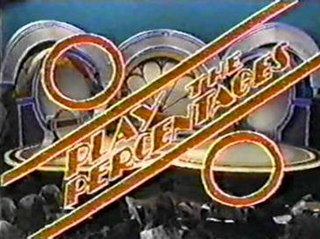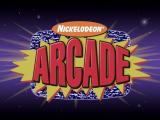
Supermarket Sweep is an American television game show. The format combines an ordinary team-based quiz show with the novel concept of a live, timed race through a supermarket. In the timed race, cameras follow the teams with shopping carts through a large vacated supermarket with several aisles; the value of items thrown into the cart determine the winning team. The original show was broadcast on ABC from December 20, 1965, to July 14, 1967. Later seasons aired on Lifetime from February 5, 1990, to June 16, 1995, and later from April 3, 2000, to May 23, 2003, with reruns airing until March 26, 2004. Another version of the show aired from October 18, 2020, to January 30, 2022, also on ABC.
Idiot Savants was an American television game show on the MTV network which ran from December 9, 1996, to April 25, 1997. It was created by Michael Dugan and Chris Kreski, directed by Steve Paley, and hosted by comedian Greg Fitzsimmons.

Get the Picture is a children's game show that aired from March 18, 1991 to December 6, 1991, with repeats until March 13, 1993 on Nickelodeon. Hosted by Mike O'Malley, the show featured two teams answering questions and playing games for the opportunity to guess a hidden picture on a giant screen made up of 16 smaller screens. The show was recorded at Nickelodeon Studios in Universal Studios, Orlando, Florida. The program's theme music and game music was composed by Dan Vitco and Mark Schultz, and produced by Schultz. Its tagline is The Great Frame Game.

Brain of Britain is a BBC radio general knowledge quiz, broadcast on BBC Radio 4.

Fun House is an American children's television game show that aired from September 5, 1988 to April 13, 1991. The first two seasons aired in daily syndication, with the Fox network picking it up and renaming it Fox's Fun House for its third and final season.
A*mazing is an Australian children's television game show that aired between 16 May 1994 until 1998 on the Seven Network. It was famous for a relatively large and elaborate maze/obstacle course that was part of the show's studio set. A*mazing was hosted by James Sherry for the entire run of the series. A*mazing was produced at Channel 7 in Brisbane from 1994–1996 and then at Channel 7 in Perth from 1997–1998.

Play the Percentages is an American game show hosted by Geoff Edwards which aired in syndication from January 7 to September 12, 1980. Jay Stewart announced for the first six weeks, after which Bob Hilton became the permanent announcer.

Shop 'til You Drop is an American game show that was on the air intermittently between 1991 and 2005. Four different series were produced during that time, with the first premiering on Lifetime on July 8, 1991, and the fourth series airing its final episode on May 27, 2005, on PAX TV.

2 Minute Drill is an ESPN game show based on the general knowledge UK game show Mastermind. The program aired from September 11, 2000 to December 28, 2001. ESPN Classic aired reruns of the series daily at 11:30 a.m. Eastern.
That's My Dog is an American game show aired on The Family Channel from September 1, 1991 to September 30, 1995. Two families and their dogs competed for prizes in games and stunts oriented toward the dogs.

Video Power is an American television series that aired in two different formats from 1990 to 1992 in syndication. Both formats revolved around video games, and actor Stivi Paskoski presided over both series playing video game master Johnny Arcade.

Uh Oh! is a Canadian television game show that was created by Rick Watts and Frank Young. Following a sneak preview at YTV Psykoblast on August 16, Uh Oh! aired from August 22, 1997 to April 19, 2003 on YTV, and was a spin-off of the popular variety show It's Alive!, which also aired on YTV. Uh Oh! was part of It's Alive's game show segment during its third season, but existed as a parody during its second season. As of 2023, Uh Oh! is the third longest-running show on YTV, behind Hit List and Video & Arcade Top 10, both of which aired for 14 and 15 years respectively. For its entire run, Uh Oh! was taped at Global Television in Toronto, Ontario. The series ended on April 19, 2003.
Skatoony is a children's live action/animated game show, pitting live-action kids against cartoons. The series was co-produced by Talent TV and FremantleMedia Animation, Blink Studios, and Marblemedia with Smiley Guy Studios. The series used to air on Cartoon Network in the UK until 2017, with new episodes airing every Friday until the series cancellation in 2008. Skatoony has also aired as re-runs in the UK on Boomerang and Cartoon Network Too until the channel itself closed down in 2014. The show aired on Starz Kids & Family in the US until 2019. Reruns were occasionally shown on Teletoon in Canada until August 5, 2017. It also aired on Boomerang in Australia and New Zealand.
The Krypton Factor is an American game show based on the UK series of the same name. Contestants on the program were tested on their mental ability and physical skill.
Challenger was an Australian children's game show that aired on the Nine Network in 1997 and 1998. The first host was Diarmid Heidenreich, famous for playing Dougie the pizza delivery guy in Pizza Hut commercials in the mid-1990s. After he left the show in early 1998 he was replaced by hosts Adrian DeVito and Zoe Sheridan. They filmed 265 episodes before the show was superseded by the return of Now You See It.

Nick Arcade is an American children's game show created by James Bethea and Karim Miteff and hosted by Phil Moore, with Andrea Lively announcing, that aired on Nickelodeon in 1992. It aired originally during weekend afternoons, with reruns airing until September 28, 1997. In the first season, the shows were taped in December 1991 and aired in early 1992. It was taped at Nickelodeon Studios at Universal Studios Florida in Orlando. In Nick Arcade, two teams of contestants played two initial trivia rounds, with the winning team advancing to the "Video Zone" to play against the virtual "Video Game Wizard" of the day.
4 Square was a British game show that aired on BBC1 from 3 May 1988 to 31 October 1991. It was hosted by Michael Groth for the first series and then hosted by John Sachs for three subsequent series.
The 3rd Degree is a British quiz show broadcast on BBC Radio 4, hosted by comedian Steve Punt and made by Pozzitive Television. The series is recorded at different universities around the country, the contestants all coming from the university in which the recording takes place. One team consists of three students and the other of three lecturers who teach the subjects the students are studying.

Ellen's Game of Games, also known as Game of Games and stylized as ellen's GAME OF GAMES, is an American television game show that aired on NBC. In March 2017, NBC ordered six hour-long episodes of the series. Ellen DeGeneres serves as host, while Stephen "tWitch" Boss appears as announcer/sidekick. The series is based on game segments from DeGeneres' daytime talk show, The Ellen DeGeneres Show. The series premiered on December 18, 2017. On February 18, 2020, DeGeneres announced on The Ellen DeGeneres Show that the series was renewed for a fourth season, which began airing on October 6, 2020. In January 2022, the series was canceled after four seasons.

Common Knowledge is an American television game show hosted by Joey Fatone that aired on Game Show Network from January 14, 2019 to August 13, 2021. On April 17, 2019, media reports stated that GSN had renewed the show for a 130-episode second season. On March 25, 2021, GSN renewed the show for a third season, which premiered on May 17, 2021.











